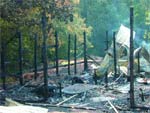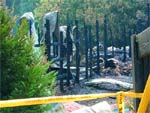Fire!
There is something about the smell of a burnt barn that you will never forget, and something about that smell and the sight of smoldering hopes, dreams and horses that should never be forgotten.
There is something about the smell of a burnt barn that you will never forget, and something about that smell and the sight of smoldering hopes, dreams and horses that should never be forgotten.
It is far too easy to become complacent about barn fire safety and it often takes a tragedy to bring this important subject to our attention.
Insurance estimates put the yearly number of barn fires in the United States at roughly 4,500 and many horse owners, who are usually very motivated about protecting their horses against illness and injury, are often lax about fire safety.
Veterinarians are looked to for information and consultation about many horse-related issues, including barn design and construction which should include discussions on barn safety. As occasional "outside" observers visiting barns on calls for any number of reasons, equine veterinarians are in a better position to see barn safety hazards that owners either overlook or have become "barn blind" to. Whenever possible, veterinarians should remind clients about fire safety and work to help them avoid this very emotional disaster.
Veterinarians' role

A 4-year-old barn in excellent condition was checked by the owner at 10 p.m. By 11:30 p.m. the barn and its eight occupants were reduced to rubble. The owner was 1,500 feet away in his home watching television. Even the best-run barns can burn with disastrous results.
"Try to determine the problems that cause most cases of barn fires," advises Jim Gibson of Landmark Structures, one of the largest barn builders in the southeast, "and then build a structure to avoid or minimize those problems."
Gibson feels that, in his experience, electrical wiring and hay storage constitute the two biggest potential fire hazards.
Frayed wires, overloaded electrical plugs and other electrical malfunctions cause one in seven barn fires.
Two biggest hazards
Start with the electrical system when fireproofing a barn. Older barns often have substandard wiring systems and existing wires can be bent, damaged or worn to the point where they are potential spark hazards. Remodeling an old barn often means rewiring to bring the electrical system up to code.
All wires should be in metal conduits to keep horses and other animals from chewing or damaging them. These conduits also protect wires from being hit by other barn equipment and from general wear. Barns should have ample outlets placed in appropriate locations. Extension cords should be discouraged for all but temporary use. Electrical cords should never be left to lie on concrete or asphalt surfaces where horses can walk on them. (Cases of electrocution have been reported where a horse stepped on and twisted its shoe on a live electrical cord in a barn aisle.) Putting electric wires in metal conduit is worthless if horses can chew on electrical cords to fans hanging on its stall, and horses that play with and push on fans with their noses and overheat their motors may be placing that barn at greater risk for a fire as well. The barn electrical system should have circuit breakers that will shut off power if a problem occurs and that will not allow power to be "reset" until that problem is resolved.
Licensed electricians familiar with barns and their electrical use should always be used and veterinarians should encourage their clients to get their barns checked by professionals if there is any question of electrical safety.
Many barns use fans in the summer and heaters in the winter, especially in the tack room or office. These appliances are often implicated in fires. Keep the use of additional electrical items to a minimum and make sure that they are turned off, preferably unplugged, when the last person leaves the barn. Do not forget about that computer on the barn office desk either. If the barn has a laundry room be sure that the dryer is properly vented and clean the lint trap with every load.
Possible troublemakers

Fire extinguishers should be checked and refilled periodically. They should be positioned at every exit and barn staff should be comfortable with using them.
In many parts of the country lightning is a significant cause of barn fires. Properly installed and maintained lightning rod systems can help reduce this particular fire risk. It is recommended that local fire departments or county extension offices be contacted for references when considering putting lightning rods on a barn.
The second highest cause of barn fires is believed to be from auto-combustion of improperly cut or stored hay.
Second highest cause
Owners should be encouraged to store hay in a separate facility if at all possible or to keep as little hay in the horse barn as possible. Storing hay above horse stalls increases the amount of dust and pollen in the environment, which can lead to more respiratory problems in general as well as a greatly increased fire risk.
If hay must be stored with horses then be sure it has been properly cut and dried. Wet hay develops microbial activity within the bales. Temperatures can elevate to more than 150 degrees. This temperature generally peaks within three to seven days as the hay "cures," but it takes 15 to 60 days to drop to normal levels depending on the air temperature, humidity, bale size and other factors. Newly baled and stacked hay should be checked twice daily during this time and a special thermometer could be used to monitor the internal bale temperature. Practically, one should buy well-dried hay and store it safely. This means using pallets or stacking the hay loosely to allow air movement around the bales. Always check for leaks above your hay storage that would allow the bales to get wet and then begin to heat up as they dried. Observe the roof during a pounding rainstorm. Small leaks may not be visible at other times.
Use all of a single hay load before adding more, and rotate the older bales to the front of your storage area. This area should be completely cleaned frequently. The hay droppings and chaff tend to build up on the floor or under the pallets, and this is the most easily combustible type of material.
Most other prevention tips are simply common sense.
Common sense
Stress no smoking policies around barns and provide sand buckets outside of barns so that smokers can properly extinguish any materials. Store any flammable cleaning supplies or gas and oil products away from the barn if possible and exercise caution when vehicles are kept near barns.
Keep halters and lead ropes in easily accessible locations (preferably at each stall). Make sure that there are enough working fire extinguishers available at several locations; and, periodically check and upgrade them.
More barns have working extinguishers than have workers that are comfortable using them. Most people have never had to fight a fire with an extinguisher, so it is often a good idea to have a barn safety day. Many veterinarians sponsor these events as a client education day that involves interested horse clients and local rescue and fire personnel. The fire officials instruct horse owners on fire safety and horse owners, then help those fire personnel without horse experience to halter and lead horses and to generally become more comfortable working with these animals. Many times firefighters arrive at a barn fire and have to help remove horses from their burning stalls. This is a difficult task even for someone familiar with horses and a daunting one for someone who may have never approached a horse before.
These workshops are generally well received by clients and foster a sense of community between horse owners, veterinarians, and fire and safety officials.
The concept of a fire plan is one of the main ideas that fire departments will stress to your clients. It is always important to work through what should happen in a disaster prior to actually experiencing one.
Have a plan
Plan on how to get a fire truck close to the barn. Many barns are located behind homes in small areas and trucks need firm footing and a large area to maneuver in. Is there a water source available near the barn? Is it sufficient to help fight a fire? If the electricity to the barn must be disconnected due to a fire, will the water pump still work? Perhaps a gas generator should be kept at the ready for such a scenario. Who will call the fire department and who will attempt to remove horses from the barn? A plan for dealing with each horse after removal from the barn is also important. Many horses will not voluntarily leave their stalls in a fire even if given the chance. Their stalls are their safe places and many horses have been taken out of a burning barn and been released only to run back into their stalls.
A plan should be put in place to have a paddock or field designated as the release point in case of a fire evacuation. Obviously, it should be a safe distance away but as close as possible because it will take time to save each horse if the release point involves excessive walking.
Most horses in barn fires die of smoke inhalation.
Cause of death
Large aisleways and high roofs cause smoke to accumulate near the ceiling and to then form over the tops of the horses' stalls. Generally, horses panic and try to escape this smoke, which usually leads them to climb the corners of the stall to get out. The horses' heads are unfortunately kept in the dense smoke cloud and their efforts and increased respirations from panic and attempts to escape cause them to inhale even more smoke. They are quickly overcome.
Many horses that do escape barn fires also have to deal with significant smoke inhalation. These horses show signs of pulmonary edema that may take a few days to develop. They must be treated aggressively with bronchodilators, antibiotics, steroids and diuretics as needed. If these horses have been burned, then fluid replacement and electrolyte management become critically important as well. Many such horses will not fully recover and maintain pulmonary damage for life.
There is no 100 percent method to prevent barn fires.
No guarantees
Sprinkler systems are undoubtedly the best, but they are very expensive and they too can malfunction. Avoiding the simple things that can cause fires and attention to electrical systems, hay storage, no smoking rules, barn appliances and common sense can all make a difference.
Veterinarians are in a position to greatly help our clients by reminding them of barn fire safety and to point out hazards observed on daily barn visits. This may make veterinarians temporarily unpopular with some clients. No one likes to have his or her barn inadequacies or potential problems pointed out. But, as with advising clients that their overweight and overfed horse is prone to founder or that their habit of erratic feedings may make their horse colic, it is the veterinarian's job to point out potential trouble before it occurs, and we owe the horses we care for at least that much.
Advising on fire safety and stressing a barn disaster plan will do much more for your clients and their horses than will any condolences after a fire.
Dr. Marcella, a 1983 graduate of Cornell University's veterinary college, was a professor of comparative medicine at the University of Virginia. His interests include muscle problems in sport horses, rehabilitation and other performance issues.